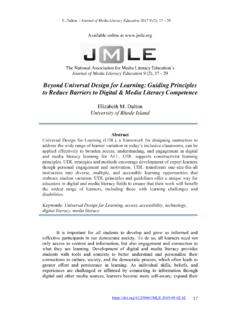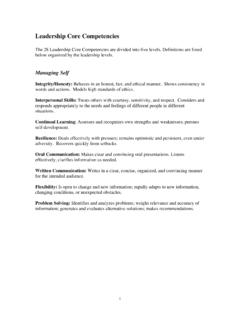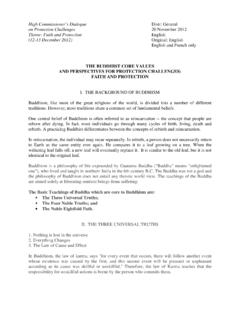Transcription of Sustainability: Definition and Five Core Principles
1 sustainability : Definition andFive core PrinciplesA New FrameworkMichael Ben-EliThe concept of sustainable development, as coined by the World Commission on Environment and Development, and with it, the term sustainability itself, have been gaining increasing recognition in recent years all around the world. Widespread use, however, has led to growing ambiguity, so that today both terms are employed within a very broad spectrum of meaning, often to the point of trivialization. The Definition and set of five sustainability Principles proposed below seeks to advance and restore rigor to the ideas underlying the concept of sustainability .
2 Its development was informed by a number of existing frameworks and was inspired, in particular, by the work of R. Buckminster Principles are articulated in a general fashion but can receive specific operational meaning in relation to particular cases, for example: sectors of the economy, development issues, business strategies, investment guidelines, or initiatives taken by individuals. These Principles are expressed in relation to five fundamental domains:The Material DomainConstitutes the basis for regulating the flow of materials and energy that underlie Economic DomainProvides a guiding framework for defining, creating and managing Domain of LifeProvides the basis for appropriate behavior in the biosphere with respect to other forms of Social DomainProvides the basis for social Spiritual Domain.
3 Identifies the necessary attitudinal orientation and provides the basis for a universal code of result is a set of five core Principles , each with its own derived policy and operational implications. The set is systemic in nature, meaning that each domain affects all the others and is affected by each in return. This systemic aspect is fundamental. It reflects the interdependent nature of reality itself. It has far-reaching implications for policy and for any competent attempt at developing a strategy for change. It implies that in seeking a transition to sustainability as the organizing principle in a new world order, a piecemeal approach emphasizing some aspects, while neglecting others is unlikely to yield effective, lasting world society and the world s economy to a sustainable basis is the most significant challenge of our time.
4 This challenge is unprecedented in scope. Its context is the planet as a whole. It requires a fundamental shift in consciousness as well as action. It calls for a fresh vision, a new dream and new approaches for shaping evolving new realities. Earth is exquisitely configured to accommodate life with abundance, but we humans have consistently compromised every vital component of its intricate fabric. This trend must be reversed and a lasting balance ultimate objective of establishing the concept of sustainability as an organizing principle for the planet is to foster a well-functioning alignment between individuals, society, the economy and the regenerative capacity of the planet s life-supporting ecosystems.
5 This alignment represents a particular type of dynamic equilibrium in the interaction between a population and the carrying capacity of its environment. It is this specific equilibrium that must be the focus of a meaningful Definition of , the prevailing Definition of sustainability emphasizes cross-generational equity, which is clearly an important concept, but which poses difficulties, since future generations needs are not easy to define or determine. Anchoring an alternative Definition to the relationship between a population and the carrying capacity of its environment offers superior operational leverage, as it contains a number of key variables, all potentially measurable: population size, rate of resource consumption, impacts on the absorption capacity of sinks, a measure of well-being, and the like.
6 Hence, the following Definition of sustainability , which applies generally to all species populations, and is true in the specific context of human population:SustainabilityA dynamic equilibrium in the process of interaction between a population and the carrying capacity of its environment such that the population develops to express its full potential without producing irreversible, adverse effects on the carrying capacity of the environment upon which it equilibrium has been greatly disturbed in our time, with the exponential intensification of human activity and the resulting demand on resources, as well as the generation of waste byproducts that exceed the planet s regeneration and absorption capacities.
7 Together, these factors make the current trajectory of human affairs Principles that follow are grounded in this Definition . They are expressed in relation to five key domains, which represent the primary dimensions of the population-environment of SustainabilityUnderlying PremiseAll the physical processes which provide the basis for human existence are subject to the primary laws of physics, for example, the first law of thermodynamics, which addresses the fundamental conservation of energy in the universe, and the second law, which stipulates the direction of energy events. These laws prescribe the ultimate limits of possibilities in physical systems and, therefore, underlie the productive potential in the use of second law underscores the ultimate increase of entropy and disorderliness in all physical systems.
8 At the same time, there are clearly cosmic processes which work to create and increase order, at least temporarily. These processes are evident on Earth in the manifest progression from simple organic molecules, to individual organisms, to societies, to whole ecosystems, and to human consciousness virtue of the innate ability to apply disciplined intelligence to designing universally advantageous configurations of energy and matter arranging and rearranging components of the physical domain humans have the potential to be powerful agents of order creation. This inherent design ability provides the essential means for ensuring lasting abundance.
9 In spite of the immense possibilities that are achievable by thoughtful superior design creating order and slowing the proliferation of entropy our current industrial infrastructure is wasteful, destructive, fragmented and grossly inefficient. With the appropriate intention, it could be reimagined, redesigned and reconfigured in order to deliver an enduring, regenerative advantage for DomainContain entropy and ensure that the flow of resources, through and within the economy, is as nearly non-declining as is permitted by physical laws. Strive for highest resource productivity Employ regenerative energy sources, and continuously recycle non-regenerative resources Amplify performance with each cycle of use Affect an unbroken, closed-loop flow of matter and energy in a planetary production infrastructure conceived as a whole Control leakages and avoid stagnation, misplaced concentrations or random diffusion of chemical elements during cycles of use Advance a service.
10 Performance-leasing orientation for managing durable goodsThe First PrinciplePolicy and Operational Implications14 Policy and Operational ImplicationsUnderlying PremiseEconomies consist of markets where transactions occur, and guiding frameworks by which transactions are evaluated and decisions about economic commitments are made. Often treated as though they reflect an independent, objective reality, such frameworks ultimately represent human constructs rooted in values, biases, and dominant interests and concerns. These latter factors determine the adoption of the underlying economic perspective: whether focused on short-term, linear and narrow objectives, or on long-term, comprehensive, eco-sensitive cycles of accounting framework presently used to guide our economy grossly distorts values.








